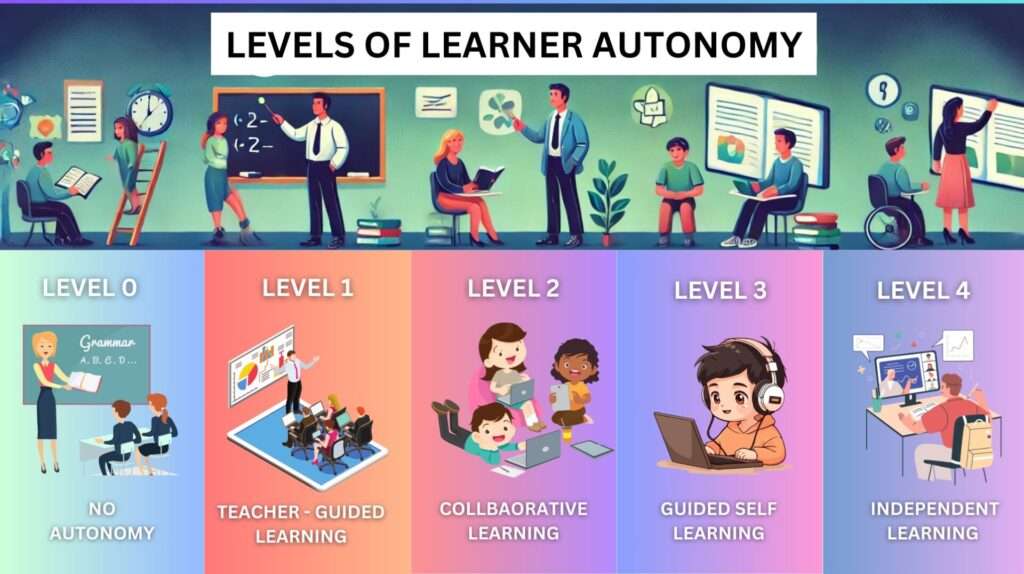It is more important than ever to support learner autonomy in the current educational environment. Given the speed at which technology is developing and the growing need for self-directed abilities, knowing the various degrees of learner autonomy can greatly improve both the teaching and learning process. This concept describes a step-by-step progression from total reliance on the instructor to total autonomy, in which students direct their own learning. By being aware of these stages, teachers can adjust their methods to better assist students in making the seamless shift from being dependent on others to being independent learners.

Level 0: No Autonomy
Description: The learner relies entirely on the teacher for guidance, instruction, and motivation. There is no initiative or self-direction in learning activities.
- Teacher Role: Fully responsible for all aspects of the learning process, including setting goals, providing materials, and directing activities.
- Student Role: Passive recipient of information and instructions, dependent on the teacher for all learning needs.
Examples: Traditional lectures, where the teacher delivers content and students take notes without engaging in independent thinking or problem-solving.
Level 1: Teacher-Guided Learning
Description: The learner begins to engage with the learning process but requires substantial guidance and direction from the teacher.
- Teacher Role: Provides structured tasks, detailed instructions, and continuous support while guiding the learner through the learning process.
- Student Role: Follows instructions, engages in tasks as directed, and starts to take some responsibility for their own learning with teacher support.
Examples: Guided practice sessions where the teacher provides step-by-step instructions and learners perform tasks under supervision.
Level 2: Collaborative Learning
Description: The learner collaborates with the teacher and peers, taking on more responsibility for their learning but still needing support and feedback.
- Teacher Role: Facilitates learning through collaborative activities, offers feedback, and gradually reduces direct instruction to encourage learner independence.
- Student Role: Actively participates in group work, contributes ideas, and starts to set personal learning goals with guidance.
Examples: Group projects or collaborative problem-solving activities where learners work together but still rely on teacher support for direction and feedback.
Level 3: Guided Self-Learning
Description: The learner takes initiative in their learning process, sets personal goals, and seeks out resources, but still requires periodic guidance and support.
- Teacher Role: Acts as a coach or mentor, providing feedback and resources, helping learners refine their goals, and supporting their self-directed efforts.
- Student Role: Takes the lead in learning activities, sets objectives, seeks out information independently, and reflects on their learning with occasional teacher input.
Examples: Independent research projects or self-paced learning modules where learners explore topics of interest and report back for feedback and guidance.
Level 4: Independent Learning with Support
Description: The learner independently manages most aspects of their learning, including setting goals and seeking resources, but still benefits from occasional support and scaffolding.
- Teacher Role: Provides minimal guidance, offers resources, and is available for consultation or troubleshooting as needed.
- Student Role: Fully responsible for their learning, proactively seeks out resources, evaluates progress, and adapts their strategies with limited teacher intervention.
Examples: Capstone projects or advanced independent study courses where learners pursue a subject in-depth with periodic check-ins for advice or support.
Level 5: Full Autonomy
Description: The learner is completely self-directed, taking full responsibility for their learning process, including goal-setting, resource management, and self-assessment.
- Teacher Role: Acts as a resource or advisor upon request but is not involved in the day-to-day learning activities.
- Student Role: Independently manages all aspects of their learning, including identifying needs, seeking out knowledge, and self-evaluating outcomes.
Examples: Self-directed learning projects, lifelong learning pursuits, or professional development activities initiated and managed entirely by the learner.
Visual Representation of Learner Autonomy Levels
| Level | Description | Teacher Role | Student Role | Examples |
|---|---|---|---|---|
| 0 | No Autonomy | Full guidance and direction | Passive recipient | Traditional lectures |
| 1 | Teacher-Guided Learning | Structured tasks and support | Follows instructions | Guided practice sessions |
| 2 | Collaborative Learning | Facilitates and provides feedback | Engages in group work | Group projects |
| 3 | Guided Self-Learning | Coach and mentor | Takes initiative with feedback | Independent research projects |
| 4 | Independent Learning with Support | Provides minimal guidance | Manages learning with occasional support | Capstone projects |
| 5 | Full Autonomy | Resource or advisor | Fully self-directed | Self-directed learning projects |
Transitioning to Higher Levels of Autonomy
Fostering learner autonomy is a progressive journey that requires careful scaffolding and support at each stage. The goal is to empower students to become self-directed learners, capable of managing their own learning processes and pursuing knowledge independently.
Empowering students to achieve full autonomy in their learning process is a transformative goal. It involves a gradual shift from structured guidance to independent exploration, supported by strategic scaffolding and ongoing feedback. As learners move through these stages, they develop the skills necessary to manage their education and personal growth effectively. By investing in this journey, we not only enhance educational outcomes but also prepare students for lifelong learning and adaptability in a dynamic world.
Ready to start your journey toward full learner autonomy? Equip yourself with the right tools by purchasing a PC from us at a subsidized rate. Begin your path to independent learning today!
